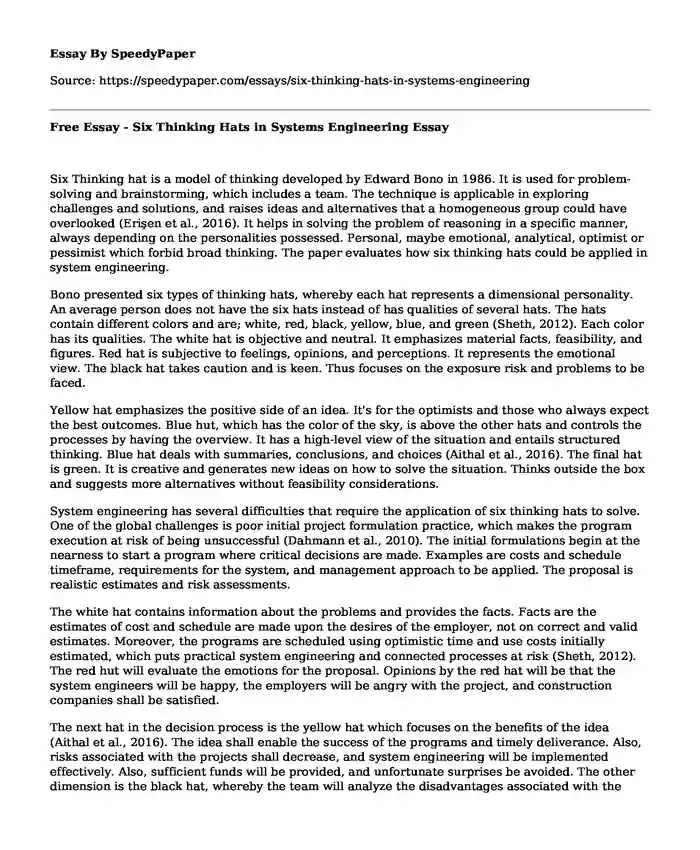
| Type of paper: | Essay |
| Categories: | Knowledge Engineering Intelligence |
| Pages: | 3 |
| Wordcount: | 730 words |
Six Thinking hat is a model of thinking developed by Edward Bono in 1986. It is used for problem-solving and brainstorming, which includes a team. The technique is applicable in exploring challenges and solutions, and raises ideas and alternatives that a homogeneous group could have overlooked (Erisen et al., 2016). It helps in solving the problem of reasoning in a specific manner, always depending on the personalities possessed. Personal, maybe emotional, analytical, optimist or pessimist which forbid broad thinking. The paper evaluates how six thinking hats could be applied in system engineering.
Bono presented six types of thinking hats, whereby each hat represents a dimensional personality. An average person does not have the six hats instead of has qualities of several hats. The hats contain different colors and are; white, red, black, yellow, blue, and green (Sheth, 2012). Each color has its qualities. The white hat is objective and neutral. It emphasizes material facts, feasibility, and figures. Red hat is subjective to feelings, opinions, and perceptions. It represents the emotional view. The black hat takes caution and is keen. Thus focuses on the exposure risk and problems to be faced.
Yellow hat emphasizes the positive side of an idea. It's for the optimists and those who always expect the best outcomes. Blue hut, which has the color of the sky, is above the other hats and controls the processes by having the overview. It has a high-level view of the situation and entails structured thinking. Blue hat deals with summaries, conclusions, and choices (Aithal et al., 2016). The final hat is green. It is creative and generates new ideas on how to solve the situation. Thinks outside the box and suggests more alternatives without feasibility considerations.
System engineering has several difficulties that require the application of six thinking hats to solve. One of the global challenges is poor initial project formulation practice, which makes the program execution at risk of being unsuccessful (Dahmann et al., 2010). The initial formulations begin at the nearness to start a program where critical decisions are made. Examples are costs and schedule timeframe, requirements for the system, and management approach to be applied. The proposal is realistic estimates and risk assessments.
The white hat contains information about the problems and provides the facts. Facts are the estimates of cost and schedule are made upon the desires of the employer, not on correct and valid estimates. Moreover, the programs are scheduled using optimistic time and use costs initially estimated, which puts practical system engineering and connected processes at risk (Sheth, 2012). The red hut will evaluate the emotions for the proposal. Opinions by the red hat will be that the system engineers will be happy, the employers will be angry with the project, and construction companies shall be satisfied.
The next hat in the decision process is the yellow hat which focuses on the benefits of the idea (Aithal et al., 2016). The idea shall enable the success of the programs and timely deliverance. Also, risks associated with the projects shall decrease, and system engineering will be implemented effectively. Also, sufficient funds will be provided, and unfortunate surprises be avoided. The other dimension is the black hat, whereby the team will analyze the disadvantages associated with the idea. There shall be delays of projects, a lengthy procedure before starting a program, and many disagreements on cost and schedules.
By using green hat dimensions, possible alternatives could be regulation of the programs by the government, signing of contracts, and standardization of costs of programs and projects involving system engineering. The blue hat determines the summary and the conclusion. In a blue hat position, the decision is to develop regulations to control the initial formulation of programs and fix costs and schedules.
References
Aithal, P. S., & Kumar, P. M. (2016). Using six thinking hats as a tool for lateral thinking in organizational problem solving. International Journal of Engineering Research and Modern Education (IJERME), 1(2), 225-234. https://papers.ssrn.com/sol3/papers.cfm?abstract_id=2883771
Dahmann, J., Lane, J. A., Rebovich, G., & Lowry, R. (2010, June). Systems of systems test and evaluation challenges. In 2010 5th International Conference on System of Systems Engineering (pp. 1-6). IEEE. https://ieeexplore.ieee.org/abstract/document/5543979/
Erisen, Y., & Katmer-Bayrakli, V. (2016). Six Hat Thinking Technique in Program Evaluation: The Evaluation of the Quality of Mathematics Teacher Training Program in Turkey. International Online Journal of Educational Sciences, 8(4). https://www.researchgate.net/profile/Y_Erisen/publication/31140074
Sheth, M. (2012). Six thinking hats. http://citeseerx.ist.psu.edu/viewdoc/summary?doi=10.1.1.409.8810
Cite this page
Free Essay - Six Thinking Hats in Systems Engineering. (2023, Aug 13). Retrieved from https://speedypaper.net/essays/six-thinking-hats-in-systems-engineering
Request Removal
If you are the original author of this essay and no longer wish to have it published on the SpeedyPaper website, please click below to request its removal:
- Free Essay on the Studies by Julia Kristeva on the Subject of the Abject
- Free Essay: Strategic Role in HRM in MNEs Now and in the Future Global Economy
- Wu Zhao and Cleopatra VII - Free Essay Comparing Ancient Female Rulers
- Essay Sample: Fear and Anxiety in Learning a Foreign Language
- Free Essay: Physical and Intellectual Changes in Middle Adulthood
- Essay Sample on Benjamin Franklin and Jonathan Edwards: Comparing Perspectives and Beliefs
- Listening: A Key to Successful Learning & Communications - Essay Sample
Popular categories




